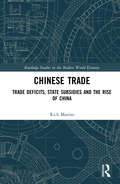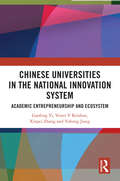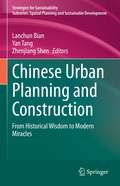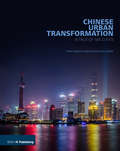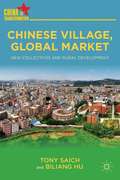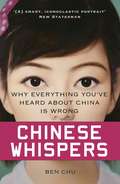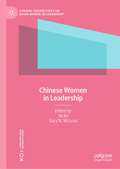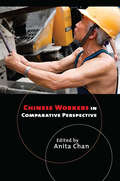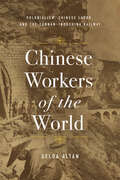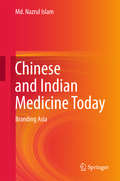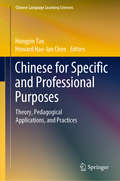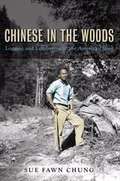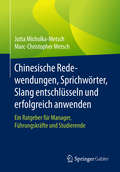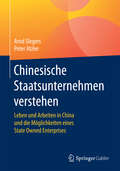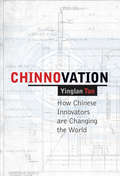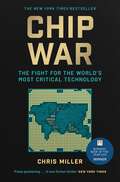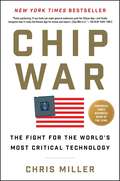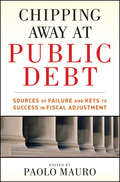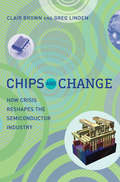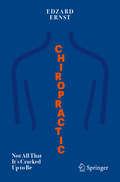- Table View
- List View
Chinese Trade: Trade Deficits, State Subsidies and the Rise of China (Routledge Studies in the Modern World Economy)
by Rich MarinoThere’s no question, compared to the advanced economies China’s economic growth rates have been spectacular, but in most instances the economic analysts tend to forget that a large part of China’s growth has been dictated by government industrial subsidies. How did China go from a bit player overnight to the largest exporter in the world in capital-intensive industries? This book shows that government subsidies play a big part in China’s success. Government subsidies include those to basic industries: energy (coal, electricity, natural gas and heavy oil), steel, glass, paper, auto parts, solar and more. A lot has been written about China’s trade practices with the West, but none of this work addresses the real unsustainable dilemma. Much of the current literature discusses the problems but doesn’t explain the root cause of China’s lopsided trade practices with the West or explain in detail how China finances its government subsidies, with nothing written that explains that China’s subsidized exports to the United States and European Union are basically self-funded by its enormous trade surplus with the West. A trade surplus represents a net inflow of domestic currency from foreign markets and is the opposite of a trade deficit, which would represent a net outflow. Moreover, this is the only book that describes China’s current trade practices with the West as a zero sum game at the expense of the West. This book provides two solutions to this endless quagmire: an increase in Western exports to China so that China and the West have more of an equal trade balance, or a very steep reduction of China’s exports to the West.
Chinese Universities in the National Innovation System: Academic Entrepreneurship and Ecosystem
by Yi Gaofeng Venni V. Krishna Xinpei Zhang Yuheng JiangThis book closely examines how universities and higher educational institutions have come to occupy a very significant position in the Chinese national Iinnovation system (NIS) in the last two decades. It looks at the growth, structure and current status of higher education in China and discusses how these world-class institutions are intimately intertwined with the rise of China in the global knowledge economy. It studies themes such as the impact of Chinese universities on industry, business enterprises and national development, relevance of higher education to policies related to industry development, reform measures to improve research intensity and quality of teaching, and internationalization and globalization of higher education. Based on sound empirical research, it also explores concepts like academic entrepreneurship, start-ups and entrepreneurial ecosystems. A key text on the Chinese education sector, the book will be of interest to scholars and researchers of higher education, Chinese studies, science, technology and innovation studies, business economics and management, academic entrepreneurship and public policy.
Chinese Urban Planning and Construction: From Historical Wisdom to Modern Miracles (Strategies for Sustainability)
by Zhenjiang Shen Lanchun Bian Yan TangThis volume introduces and discusses the achievements and mechanisms of urban planning and construction in China from multiple professional perspectives, covering practices and processes ranging from ancient times to the present day. The book has 14 chapters, each addressing a specific Chinese urban planning and construction topic with examples and applications in various cities and regions, and each providing an all-around analysis of Chinese urban development issues at different scales, including government administrations, planning progresses, urban investments, social impacts and construction models. The book provides a comprehensive overview of urban planning and construction in China, especially its successful experiences in the historical period and modern era, which will greatly benefit scholars and readers who are interested in China, as well as urban planners, architects and historians. The book is organized into 4 main parts. Part 1 focuses on "historical wisdom" to summarize ancient Chinese efforts to cope with nature and the environment. It interprets the unique wisdom of ancient Chinese cities related to regional design, water conservancy system, and urban districts. Part 2 presents the “transformation" of urban planning in China by learning from both the traditional value and western experiences based on several cases, such as the spatial development of Beijing and the Beijing-Tianjin-Hebei capital region, the preservation of Qingdao city, the urban community development and regeneration in Chongqing city. Part 3 explores the "green and eco-city" by looking towards the future, illustrating Chinese practices and efforts to build more sustainable cities, such as green and low-carbon city construction in Wuhan, healthy city planning and eco-cities construction in China. Part 4 prospects the “modern miracles” brought forth by technological innovation and economic growth, and introduces the newest planning trends in China, such as the E-commerce Taobao villages in China and the innovation districts in Beijing. It also explains the driving force of the "growth machine" of Suzhou city.
Chinese Urban Transformation: A Tale of Six Cities
by Chen Yuanzhi Alan Hudson He LishengNow an established global force, China has experienced a sustained period of staggering economic growth since policy reform in the 1970s. Chinese urbanisation is the most significant example of economic, environmental and social change both within China and globally. In recent years, central government has made a concerted effort to encourage city governments to realign their priorities and achieve a balance between economic efficiency, social justice and environmental protection. Chinese Urban Transformation: A Tale of Six Cities is a fascinating exploration of the dramatic development Chinese cities have undergone. Tracing this transformation through a comprehensive analysis of social and economic change in six cities, it unravels the complex relationship between policy, outlook and role that urban development plays in China’s view of itself, including the tensions resulting from rapid social and economic change.
Chinese Village, Global Market
by Tony Saich Biliang HuThe story of one village, Yantian, and its remarkable economic and social transformation, this book shows how outcomes are shaped by a number of factors such as path dependence, social structures, economic resources and local entrepreneurship.
Chinese Whispers: Why Everything You've Heard About China is Wrong
by Ben Chu'Chu's smart, iconoclastic portrait dismantles seven misconceptions' (New Statesman) about modern China and offers a corrective to Western assumptions.THE CHINESE ARE THE MOST HARDWORKING PEOPLE ON EARTH...so why are the younger generation derided as spoiled and lazy?CHINESE PEOPLE DON'T CARE ABOUT POLITICAL FREEDOM...so why is the country's internet exploding with anti-regime dissent?CHINA WILL ONE DAY RULE THE WORLD...so why do the country's political leaders feel so insecure?Perhaps it is time to stop engaging in a centuries-old game of Chinese whispers in which the facts have become more and more distorted in the telling.Ben Chu examines the myths that have come to dominate our view of the world's most populous nation, forcing us to question everything we thought we knew about it. The result is a penetrating, surprising and provocative insight into China today.
Chinese Whispers: Why Everything You've Heard About China is Wrong
by Ben Chu'Chu's smart, iconoclastic portrait dismantles seven misconceptions' [NEW STATESMEN] about modern China and offers a corrective to Western assumptions.THE CHINESE ARE THE MOST HARDWORKING PEOPLE ON EARTH...so why are the younger generation derided as spoiled and lazy?CHINESE PEOPLE DON'T CARE ABOUT POLITICAL FREEDOM...so why is the country's internet exploding with anti-regime dissent?CHINA WILL ONE DAY RULE THE WORLD...so why do the country's political leaders feel so insecure?Perhaps it is time to stop engaging in a centuries-old game of Chinese whispers in which the facts have become more and more distorted in the telling.Ben Chu examines the myths that have come to dominate our view of the world's most populous nation, forcing us to question everything we thought we knew about it. The result is a penetrating, surprising and provocative insight into China today.
Chinese Women in Leadership (Current Perspectives on Asian Women in Leadership)
by Gary N. McLean Jie KeThis edited collection highlights the unique cultural and socioeconomic elements of China and the strong influence of those elements on women leaders in the nation. The authors present perspectives on women leaders’ current state of working conditions and balancing of personal and professional lives in diverse contexts while discussing commonalities and differences across sectors in China and drawing comparisons with Asian and non-Asian contexts. Chapters will explore cultural contexts that hinder career advancement, family roles for women, government policies and educational opportunities that support women's development, and finally the future for women in China. The book provides a thorough assessment of the situation of women in China for scholars in leadership, management, international relations, and human resource development.
Chinese Workers in Comparative Perspective
by Anita ChanAs the "world's factory" China exerts an enormous pressure on workers around the world. Many nations have had to adjust to a new global political and economic reality, and so has China. Its workers and its official trade union federation have had to contend with rapid changes in industrial relations. Anita Chan argues that Chinese labor is too often viewed from a prism of exceptionalism and too rarely examined comparatively, even though valuable insights can be derived by analyzing China's workforce and labor relations side by side with the systems of other nations.The contributors to Chinese Workers in Comparative Perspective compare labor issues in China with those in the United States, Australia, Japan, India, Pakistan, Germany, Russia, Vietnam, and Taiwan. They also draw contrasts among different types of workplaces within China. The chapters address labor regimes and standards, describe efforts to reshape industrial relations to improve the circumstances of workers, and compare historical and structural developments in China and other industrial relations systems. Contributors: Frederick Scott Bentley, Rutgers, The State University of New Jersey; Florian Butollo, Friedrich-Schiller University, Germany; Anita Chan, University of Technology, Sydney, and Australian National University; Chris King-chi Chan, City University of Hong Kong; Yu-bin Chiu, National Pingtung University of Education, Taiwan; Sean Cooney, University of Melbourne; Mary Huong Thi Evans, Rutgers, The State University of New Jersey; Navjote Khara, Niagara College; Kevin Lin, University of Technology, Sydney; Mingwei Liu, Rutgers, The State University of New Jersey; Peter Lund-Thomsen, Copenhagen Business School and Nottingham Business School; Boy Lüthje, Institute of Social Research, Frankfurt, Germany and Sun Yat-Sen University, China, and the East-West Center, Honolulu; Khalid Nadvi, University of Manchester; Thomas Nice, Australian Indigenous Mentoring Experience; Tim Pringle, SOAS, University of London; Katie Quan, University of California-Berkeley and Sun Yat-Sen University, China; Susan J. Schurman, Rutgers, The State University of New Jersey; Kaxton Siu, Chinese University of Hong Kong; Hong Xue, East China Normal University, Shanghai
Chinese Workers of the World: Colonialism, Chinese Labor, and the Yunnan–Indochina Railway
by Selda AltanChinese workers helped build the modern world. They labored on New World plantations, worked in South African mines, and toiled through the construction of the Panama Canal, among many other projects. While most investigations of Chinese workers focus on migrant labor, Chinese Workers of the World explores Chinese labor under colonial regimes within China through an examination of the Yunnan-Indochina Railway, constructed between 1898–1910. The Yunnan railway—a French investment in imperial China during the age of "railroad colonialism"—connected French-colonized Indochina to Chinese markets with a promise of cross-border trade in tin, silk, tea, and opium. However, this ambitious project resulted in fiasco. Thousands of Chinese workers died during the horrid construction process, and costs exceeded original estimates by 74%. Drawing on Chinese, French, and British archival accounts of day-to-day worker struggles and labor conflicts along the railway, Selda Altan argues that long before the Chinese Communist Party defined Chinese workers as the vanguard of a revolutionary movement in the 1920s, the modern figure of the Chinese worker was born in the crosscurrents of empire and nation in the late nineteenth century. Yunnan railway workers contested the conditions of their employment with the knowledge of a globalizing capitalist market, fundamentally reshaping Chinese ideas of free labor, national sovereignty, and regional leadership in East and Southeast Asia.
Chinese and Indian Medicine Today: Branding Asia
by Md. Nazrul IslamThis book discusses Asian medicine, which puts enormous emphasis on prevention and preservation of health, and examines how, in recent decades, medical schools in Asia have been increasingly shifting toward a curative approach. It offers an ethnographic investigation of the scenarios in China and India and finds that modern students and graduates in these countries perceive Asian medicine to be as important as Western medicine. There is a growing tendency to integrate Asian medicine with Western medical thought in the academic curriculum that has led to a gradual decline of Asian medical thought and practices. At the same time, there has been a massive rise in patent drugs, health products and cosmetics being sold under the brand names of Asian medicine or herbal medicine. Most of these drugs and health products do not follow the classical formulas found in the Asian medical texts. The book analyses these texts and concludes that contemporary Asian medicine rarely follows the classical texts, and in fact uses Asian medicine brands to sell Western health products and practices.With a particular focus on the formal and professional sector of Chinese herbal medicine and Indian ayurvedic medicine in urban areas, this book appeals to a broad readership, including undergraduate students and academics as well as non-experts.Md. Nazrul Islam is an Associate Professor in the General Education Office, United International College, Beijing Normal University-Hong Kong Baptist University. He was a Visiting Associate Professor in the School of Population and Public Health, University of British Columbia (2015-16) during which time he completed this book manuscript.
Chinese for Specific and Professional Purposes: Theory, Pedagogical Applications, and Practices (Chinese Language Learning Sciences)
by Hongyin Tao Howard Hao-Jan ChenThis book, likely the first of its kind in the English language, explores Chinese for specific and professional purposes (CSP) in terms of theorizing and developing practical applications for language teaching and learning. While research in language for specific purposes is thriving for languages such as English, there has been comparatively little such research conducted for Chinese. This volume attempts to fill the gap by bringing together practitioners from a broad international scholarly community, who share common interests yet diverse orientations. Seventeen papers are included, and address four broad thematic categories: (1) academic Chinese, (2) business Chinese, (3) Chinese for medicine and health care, and (4) Chinese for other broadly defined services and industries (diplomacy, tourism, wine-tasting, etc.). Representing the state of the art in CSP research, the book offers an indispensable guide for anyone interested in theoretical and practical issues in this area of applied Chinese language studies.
Chinese for Specific and Professional Purposes: Theory, Pedagogical Applications, and Practices (Chinese Language Learning Sciences)
by Hongyin Tao Howard Hao-Jan ChenThis book, likely the first of its kind in the English language, explores Chinese for specific and professional purposes (CSP) in terms of theorizing and developing practical applications for language teaching and learning. While research in language for specific purposes is thriving for languages such as English, there has been comparatively little such research conducted for Chinese. This volume attempts to fill the gap by bringing together practitioners from a broad international scholarly community, who share common interests yet diverse orientations. Seventeen papers are included, and address four broad thematic categories: (1) academic Chinese, (2) business Chinese, (3) Chinese for medicine and health care, and (4) Chinese for other broadly defined services and industries (diplomacy, tourism, wine-tasting, etc.). Representing the state of the art in CSP research, the book offers an indispensable guide for anyone interested in theoretical and practical issues in this area of applied Chinese language studies.
Chinese in the Woods: Logging and Lumbering in the American West
by Sue Fawn ChungThough recognized for their work in the mining and railroad industries, the Chinese also played a critical role in the nineteenth-century lumber trade. Sue Fawn Chung continues her acclaimed examination of the impact of Chinese immigrants on the American West by bringing to life the tensions, towns, and lumber camps of the Sierra Nevada during a boom period of economic expansion. Chinese workers labored as woodcutters and flume-herders, lumberjacks and loggers. Exploding the myth of the Chinese as a docile and cheap labor army, Chung shows Chinese laborers earned wages similar to those of non-Asians. Men working as camp cooks, among other jobs, could make even more. At the same time, she draws on archives and archaeology to reconstruct everyday existence, offering evocative portraits of camp living, small town life, personal and work relationships, and the production and technical aspects of a dangerous trade. Chung also explores how Chinese used the legal system to win property and wage rights and how economic and technological change ultimately diminished Chinese participation in the lumber industry. Eye-opening and meticulous, Chinese in the Woods rewrites an important chapter in the history of labor and the American West.
Chinesische Redewendungen, Sprichwörter, Slang entschlüsseln und erfolgreich anwenden
by Jutta Micholka-Metsch Marc-Christopher MetschDieses Buch veranschaulicht praxisorientiert die Bedeutungen von weit verbreiteten chinesischen Sprichwörtern, Redewendungen und Slang und ihre möglichen Anwendungen in Business und Alltag. „Bei uns in China sagt man…“ – früher oder später fällt dieser Satz im Gespräch mit chinesischen Geschäfts- und Gesprächspartnern. Und die sich anschließenden Wendungen sind für Westler nicht immer leicht zu entschlüsseln. Oft enthalten sie eine versteckte Botschaft an den Gesprächspartner. Die Idiome sind für ein schnelles Nachschlagen nach Kategorien geordnet und werden anhand von zahlreichen Praxisbeispielen erläutert. Die Autoren richten sich an Manager und Expatriates, Studierende und Schüler in Austauschprogrammen, die an einem Einblick in das Zusammenleben und die kulturellen Gepflogenheiten im heutigen modernen China interessiert sind.
Chinesische Staatsunternehmen verstehen: Leben und Arbeiten in China und die Möglichkeiten eines State Owned Enterprises
by Arnd Slegers Peter AtzlerDieses Buch liefert wertvolle Handlungsempfehlungen aus erster Hand f#65533;r den Aufbau von Gesch#65533;ftsbeziehungen in China mit einem besonderen Augenmerk auf eine T#65533;tigkeit in einem chinesischen Staatsunternehmen. Chinesische Staatsunternehmen (State Owned Enterprises, SOE) sind mit einem Millionen-Heer an Mitarbeitern von gro#65533;er Bedeutung f#65533;r die chinesische Volkswirtschaft. Bisher haben viele westliche Unternehmen die SOE wegen ihrer Komplexit#65533;t als Kunden, Partner oder Arbeitgeber gemieden. Um weiterhin erfolgreiche Chinastrategien zu realisieren, lohnt es sich f#65533;r westliche Leser sehr, sich mit diesem Wirtschaftssegment, seinen Strukturen und Funktionsweisen n#65533;her zu besch#65533;ftigen. Ein Schwerpunkt liegt auf der Automobilindustrie. Die Erkenntnisse aus dieser spannenden Innenansicht sind auf alle Wirtschaftszweige #65533;bertragbar.
Chinnovation
by Yinglan TanIt is widely-believed that China's entrepreneur has grown and their businesses are succeeding primarily due to their knowledge of the domestic market, quick adaptation to market changes, and their resourcefulness. But innovation? Forget about it. Well, not quite. Drawing on a wealth of on-the-ground stories and thorough research, Chinnovation: How Chinese Innovators Are Changing the World shows how Chinese companies of every stripe have dispelled this myth and overcome the barriers to successful, profitable innovation. How did Neil Shen, co-founder of CTRIP Capital China, see the opportunity for a Chinese travel site? How did Ray Zhang, CEO of Ehi, scale up one of the most innovative hybrid car-rental companies in China? How did Zhang Tao, CEO of Dianping, start a ZAGAT-inspired user-review site for restaurants and establish a continuous process of innovation? Yinglan Tan has spent more than five years learning the secrets of Chinese innovators, a fast-growing subculture playing key roles in China's transformative transition from "Made in China" to "Innovated in China. " Learn: What is the path that an innovative Chinese private-owned enterprise take? How blue-chip innovators remix business models successfully in China? What are the capabilities that these innovative companies acquire? How they harness the necessary resources and navigate around legal restrictions? How do they attract, train and retain talent? How do these companies experiment with innovative approaches and also manage the risk of innovation? What are the lessons learnt and how would these entrepreneurial innovators advise others who are embarking on the same journey? China's rapid economic growth has made it a crucial market but multinational corporations are now competing with China's own homegrown businesses. Chinnovation: How Chinese Innovators Are Changing The World uncovers the common threads amongst Chinese entrepreneurs as they reach into a wider world.
Chip War: The Fight for the World's Most Critical Technology
by Chris Miller***Winner of the 2022 Financial Times Business Book of the Year Award*** ***Selected as one of Barack Obama's Favourite Books of 2023***'Pulse quickening. A nonfiction thriller - equal parts The China Syndrome and Mission Impossible' New York Times An epic account of the decades-long battle to control the world's most critical resource—microchip technology Power in the modern world - military, economic, geopolitical - is built on a foundation of computer chips. America has maintained its lead as a superpower because it has dominated advances in computer chips and all the technology that chips have enabled. (Virtually everything runs on chips: cars, phones, the stock market, even the electric grid.) Now that edge is in danger of slipping, undermined by the naïve assumption that globalising the chip industry and letting players in Taiwan, Korea and Europe take over manufacturing serves America's interests. Currently, as Chip War reveals, China, which spends more on chips than any other product, is pouring billions into a chip-building Manhattan Project to catch up to the US. In Chip War economic historian Chris Miller recounts the fascinating sequence of events that led to the United States perfecting chip design, and how faster chips helped defeat the Soviet Union (by rendering the Russians&’ arsenal of precision-guided weapons obsolete). The battle to control this industry will shape our future. China spends more money importing chips than buying oil, and they are China's greatest external vulnerability as they are fundamentally reliant on foreign chips. But with 37 per cent of the global supply of chips being made in Taiwan, within easy range of Chinese missiles, the West's fear is that a solution may be close at hand. 'A riveting history. Features vivid accounts and colourful characters' Financial Times'Fascinating … A historian by training, Miller walks the reader through decades of semiconductor history – a subject that comes to life thanks to [his] use of colorful anecdotes' Forbes 'Indispensable' Niall Ferguson
Chip War: The Fight for the World's Most Critical Technology
by Chris MillerThe Financial Times Business Book of the Year, this epic account of the decades-long battle to control one of the world&’s most critical resources—microchip technology—with the United States and China increasingly in fierce competition is &“pulse quickening…a nonfiction thriller&” (The New York Times).You may be surprised to learn that microchips are the new oil—the scarce resource on which the modern world depends. Today, military, economic, and geopolitical power are built on a foundation of computer chips. Virtually everything—from missiles to microwaves—runs on chips, including cars, smartphones, the stock market, even the electric grid. Until recently, America designed and built the fastest chips and maintained its lead as the #1 superpower, but America&’s edge is in danger of slipping, undermined by players in Taiwan, Korea, and Europe taking over manufacturing. Now, as Chip War reveals, China, which spends more on chips than any other product, is pouring billions into a chip-building initiative to catch up to the US. At stake is America&’s military superiority and economic prosperity. Economic historian Chris Miller explains how the semiconductor came to play a critical role in modern life and how the US became dominant in chip design and manufacturing and applied this technology to military systems. America&’s victory in the Cold War and its global military dominance stems from its ability to harness computing power more effectively than any other power. Until recently, China had been catching up, aligning its chip-building ambitions with military modernization. Here, in this paperback edition of the book, the author has added intriguing new material focused on "America's Chip Comeback,&” which overviews the global consequences of the just passed CHIPS Act, the new export controls on China, and the effort to rally allies to better guard chip technology. Illuminating, timely, and fascinating, Chip War is &“an essential and engrossing landmark study&” (The Times, London).
Chip and Joanna Gaines' Magnolia Network
by Anita Elberse Julia McNicholasChip and Joanna Gaines, who have shot to fame as stars of the hit television show Fixer Upper, are preparing to launch their own television network. It is April 2019, a year since the home-renovation show Fixer Upper's fifth season on cable channel HGTV ended, and more than one-and-a-half years since the husband-and-wife duo announced that season would be their last. At the time, entertainment company Discovery Inc. was in the process of acquiring, in a $12-billion deal, Scripps Networks Interactive, HGTV's parent company. Now, hoping to find a way to bring the duo back, Discovery's chief executive officer David Zaslav has proposed setting up a joint venture between Discovery and the Gaineses. Under the deal, the latter will receive an ownership stake as well as certain guaranteed payments, be given creative control over the 'DIY Network' which they plan to rebrand as 'Magnolia Network,' and have a sizable programming budget at their disposal. Meanwhile, the two entrepreneurs are also running a thriving set of other businesses under their 'Magnolia' brand, that covers retail and hospitality-including their 'Magnolia Market at the Silos' complex and 'Magnolia Table' restaurant in Waco, Texas-as well as brand partnerships, books, and a magazine. Is launching Magnolia Network the right move for Chip and Joanna Gaines-and for Discovery? And what can both parties do to ensure the new network will be a success?
Chipping Away at Public Debt: Sources of Failure and Keys to Success in Fiscal Adjustment
by Paolo MauroPath-breaking research on one of the most important macroeconomic policy challenges in the post-crisis world, presented in accessible languageWritten and researched by a team of experts from the International Monetary Fund, other policy-making institutions, and academia, this timely book looks at fiscal adjustment plans in advanced economies, comparing the planned or projected reductions in debts and deficits to the actual outcomes, and explaining why objectives were met in some cases but missed in others. An overview reveals pitfalls to avoid and lessons learned for securing successful fiscal adjustment.Written by experts in the fieldAddresses public concern about skyrocketing government debtsContains cutting edge research that changes the way we look at fiscal adjustmentPresents meticulous archival research in compelling and engaging case studiesExplores lessons learned and policy implications going forwardIncludes country coverage of all G7 and European Union economiesEducating and informing investors, economists, and the general public, this important book looks at why some attempts to curb debts and deficits succeed whereas others fail, as well as how to ensure successful fiscal adjustment in the period ahead.
Chips and Change: How Crisis Reshapes the Semiconductor Industry
by Clair Brown Greg LindenHow the chip industry has responded to a series of crises over the past twenty-five years, often reinventing itself and shifting the basis for global competitive advantage.For decades the semiconductor industry has been a driver of global economic growth and social change. Semiconductors, particularly the microchips essential to most electronic devices, have transformed computing, communications, entertainment, and industry. In Chips and Change, Clair Brown and Greg Linden trace the industry over more than twenty years through eight technical and competitive crises that forced it to adapt in order to continue its exponential rate of improved chip performance. The industry's changes have in turn shifted the basis on which firms hold or gain global competitive advantage.These eight interrelated crises do not have tidy beginnings and ends. Most, in fact, are still ongoing, often in altered form. The U.S. semiconductor industry's fear that it would be overtaken by Japan in the 1980s, for example, foreshadows current concerns over the new global competitors China and India. The intersecting crises of rising costs for both design and manufacturing are compounded by consumer pressure for lower prices. Other crises discussed in the book include the industry's steady march toward the limits of physics, the fierce competition that keeps its profits modest even as development costs soar, and the global search for engineering talent.Other high-tech industries face crises of their own, and the semiconductor industry has much to teach about how industries are transformed in response to such powerful forces as technological change, shifting product markets, and globalization. Chips and Change also offers insights into how chip firms have developed, defended, and, in some cases, lost global competitive advantage.
Chiquita Brands International (A)
by Debora L. Spar Terence MulliganWhen a new banana import policy is implemented in 1993 by the European Union, Chiquita Brands International, the world's largest banana distributor, watches its sales and net income plummet. The policy, Council Regulation (EEC 404/93), uses a new tariff and quota scheme to support the import of European territory bananas and significantly reduce Latin American banana imports, Chiquita's primary business. As a result, Chiquita sustains losses totaling $400 million between 1992 and 1994. To combat the EU policy, Chiquita files a Section 301 Petition with the U.S. Trade Representative. Yet CEO Keith Linde knows that even a successful 301 investigation can produce only medium-to long-term results. In 1995, Chiquita still faces the immediate necessity of improving the company's grim financial position.
Chiquita Brands International (B)
by Debora L. Spar Briana HuntsbergerSupplements the (A) case. A rewritten version of an earlier supplement.
Chiropractic: Not All That It's Cracked Up to Be
by Edzard ErnstOf all forms of alternative medicine, chiropractic is the one that is most generally accepted. In the UK, for instance, chiropractors are regulated by statute and even have their own ‘Royal College of Chiropractic’. In the US, chiropractic’s country of origin, most chiropractors carry the title ‘doctor’ and many consumers believe they are medically trained. Despite this high level of acceptance, chiropractic is wide open to criticism. The claims and assumptions made by chiropractors are far from evidence based. Chiropractic manipulations are of doubtful effectiveness and have regularly been associated with severe adverse effects, including multiple fatalities. The advice issued by chiropractors to patients and consumers is often less than responsible. The behaviour of chiropractors and their organisations is frequently less than professional. This book presents and discusses recent evidence in and around chiropractic in a factual and unemotional manner. It amounts to an evidence-based critique of this profession and discloses the often dangerously misleading information published for the lay audience. It thereby contributes to advancing public health and critical thinking.
